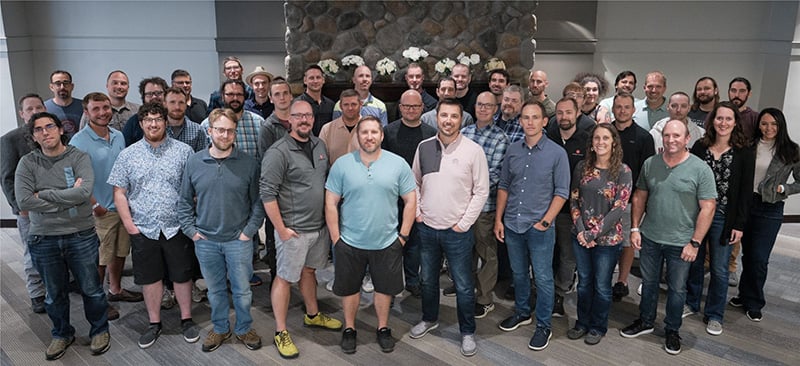In This Blog:
If your team is about to inherit a legacy codebase, rebuild a product, or add major new features, it’s important to pause and ask: What shape is the code really in?
That’s where a code audit makes all the difference. It helps uncover what’s really been built, reveal hidden risks, and guide smarter decisions about where to invest next.
At Emergent Software, we’ve conducted code audits for all kinds of clients, from startups with fast-moving MVPs to enterprise organizations managing complex, multi-layered systems. The goal is always the same: to bring clarity, reduce surprises, and help development teams move forward with confidence.
When Should You Do a Code Audit?
There’s no one “right time” for a code audit, but certain moments make it especially valuable. If you're facing any of these, it might be time to take a closer look at your code:
-
You’ve inherited a codebase from another team or vendor and want to understand what you're working with.
-
Your product has hit MVP and you’re getting ready to scale it.
-
You're preparing for a security, compliance, or cloud migration effort.
-
Leadership is trying to decide whether to rebuild, refactor, or continue with the current system.
-
Readiness for a new feature is being investigated, and you need to ensure the foundation can handle it.
In short, a code audit is a smart move whenever there’s uncertainty about what’s inside the codebase or how well it can support your future goals.
Code Review vs. Code Audit vs. Security Assessment
These terms often get used interchangeably, but they serve different purposes.
Code reviews are routine, incremental checks done during active development. They help developers catch bugs, ensure consistency, and share context as work progresses.
Security assessments focus specifically on identifying vulnerabilities. They dive deep into encryption, authentication methods, and infrastructure configurations to make sure systems are protected from potential threats.
Code audits take a broader view. They evaluate an entire application across several categories like code quality, architecture, security, performance, and more. We often include a security assessment as part of a larger audit, but the audit itself is designed to give a holistic understanding of the codebase.
What We Look for in a Code Audit
When we conduct a code audit at Emergent Software, we focus on several core areas. Each one plays a role in determining whether a codebase is healthy, maintainable, and ready for what’s next.
-
Code Quality and Readability
We assess how easy it is to follow the logic of the code. Are naming conventions consistent? Are modules organized logically? Can another developer step in and understand what’s going on without spending hours reverse-engineering it?
-
Security
We look for hard-coded secrets, lack of input validation, or outdated libraries that could create vulnerabilities. Security through obscurity isn’t a valid strategy in 2025, and we flag anything that puts sensitive data at risk.
-
Architecture and Design
We examine how the application is structured. Is it modular and scalable? Can it adapt to new business needs, or is it brittle and difficult to extend?
-
Performance
We identify potential bottlenecks or resource-heavy processes that could affect speed and stability. This includes things like redundant queries, excessive memory usage, or inefficient loops.
-
Dependencies
We check whether libraries and frameworks are up to date, or if the project is relying on outdated components that may be unsupported or pose security risks.
-
Accessibility and SEO
For public-facing sites, accessibility and search engine optimization can’t be ignored. We use tools like Google Lighthouse to evaluate how well the app meets usability standards and how well it can be indexed and discovered online.
Every codebase is unique, so our recommendations are tailored to the context and goals of the business. What’s critical in one application might be irrelevant in another.
Common Red Flags We Encounter
In my experience, I see some issues pop up again and again. These are some of the red flags I see most often:
-
Hard-coded credentials that should be stored in a secure configuration system
-
No automated tests or very low test coverage, making it harder to validate future changes
-
Outdated dependencies, including unsupported versions of frameworks or packages
-
Duplicated logic and inconsistent naming conventions that make maintenance harder
-
Over-abstracted code, often built for features that never materialized
-
Missing or outdated documentation, which slows onboarding and troubleshooting
Sometimes these problems come from time constraints or shifting priorities. Other times, they’re the result of inexperience or poor handoffs. In any case, they’re fixable, but only if you know they’re there.
Our Step-by-Step Process
Here’s what our typical code audit looks like, from first contact to final deliverable.
1. Get Access to the Code
We start by getting access to the application source code—usually through a repository, but sometimes as a file download. The more complete the codebase, the more accurate our findings.
2. Run Manual and Automated Reviews
Our team does a high-level manual review to spot architectural patterns and code smells. We also use tools like SonarQube, OWASP ZAP, and Google Lighthouse to uncover issues related to security, accessibility, and quality.
3. Build and Run the Application
If we’re able to compile and run the system locally, we do. Seeing the application in action helps us understand how it behaves and catch issues that only surface at runtime.
4. Talk to People Who Built It
Code doesn’t always explain itself. We often reach out to developers or stakeholders who worked on the system to get more context. These conversations are incredibly helpful for interpreting odd patterns or understanding business logic.
5. Score and Prioritize Findings
We use an internal checklist to identify common problems and prioritize them based on severity and impact. It’s not a pass/fail system, it’s a set of signals that help guide smarter decisions.
6. Deliver the Results
We provide a written report that outlines key findings, supported by a presentation that summarizes scores across the core categories. The presentation is tailored to the audience, whether that’s a technical team, executives, or a mix.
How to Maintain Code Quality Over Time
You don’t need a full audit every quarter to stay on top of your code. There are simple practices that can keep a codebase healthy, even between reviews:
-
Enforce consistent code reviews, with clear standards for acceptance
-
Set realistic boundaries on abstraction—build for what’s needed now, not every possible future
-
Keep dependencies up to date, especially major frameworks
-
Automate where you can. Use linters, pre-commit hooks, and CI tools to catch issues early
-
Assign ownership of the codebase, so someone is always accountable
-
Document edge cases and decisions, especially when context matters
-
Schedule regular internal reviews, even without an external auditor
Code doesn’t fail all at once. But it ages. And when no one’s been keeping it clean, eventually, no one wants to touch it. So make sure to stay on top of it!
Final Thoughts
A code audit is a smart move when you're planning to invest in your software. It helps you understand what’s under the surface, catch potential issues early, and move forward with clarity and confidence.
Whether you’re prepping for a rebuild, taking over someone else’s code, or just want to validate the state of your system, a code audit can provide the clarity you need to move forward.
Want to Know What’s Under the Hood?
Emergent Software helps teams uncover hidden issues and strengthen their codebases for long-term growth. Get in touch with us and let’s make sure your next big investment is built on a strong foundation.
FAQ
What is a code audit, exactly?
A code audit is a comprehensive, high-level review of an application’s source code. It’s designed to give you a clear understanding of how the code was written, how secure and scalable it is, and what kind of technical debt may be lurking under the surface. Much like you’d get an inspection before buying a house or a car, a code audit helps you know exactly what you’re getting into before making a major investment, whether that’s in time, budget, or developer resources. It’s not about pointing fingers or assigning blame. It’s about identifying potential issues early and helping teams make informed decisions about how to move forward confidently.
When should I get a code audit done?
While there’s no single “perfect” time to conduct a code audit, there are several key inflection points where it becomes especially important. If you’re inheriting a codebase from another team or vendor, preparing to scale after reaching MVP, or facing a major rebuild or refactor decision, an audit gives you the insights you need. It’s also incredibly helpful before large feature rollouts, cloud migrations, or compliance reviews. Essentially, whenever there's uncertainty about what condition the code is in, or whether it can support future goals, a code audit can remove the guesswork. It’s a proactive step that helps you avoid future delays, bugs, or costly missteps.
What’s the difference between a code audit and a code review?
Code reviews and code audits both serve the goal of improving software quality, but they happen at different levels and for different reasons. A code review is typically a peer-to-peer process where developers check each other’s work during ongoing development. These reviews are often informal, focused on individual pull requests, and happen multiple times a week within a project team. A code audit, on the other hand, is a broader, more structured process conducted by a separate team looking at the full codebase. It covers areas like architecture, security, performance, and scalability. While code reviews help in the short term, code audits provide long-term clarity.
Do you include security assessments in a code audit?
Yes, but with some nuance. Every code audit we do includes a security component, where we review the code for risky patterns like hard-coded credentials, missing input validation, and outdated dependencies that could lead to vulnerabilities. However, a dedicated security assessment usually goes deeper, reviewing the application’s infrastructure, environment configuration, and how data flows between systems. In other words, we look at what’s baked into the code itself during an audit. If you need a more robust, system-wide evaluation, we can either expand the audit or recommend a full security review as a follow-up.
What are some common red flags you look for in a code audit?
There are several issues we tend to encounter again and again, many of which can have serious implications if not addressed. One major red flag is the presence of hard-coded credentials, which not only pose a security risk but also create long-term maintenance challenges. Another is lack of automated tests or very low test coverage, which makes it difficult to safely change or expand the application without introducing bugs. We also frequently see outdated libraries, duplicated or inconsistent code, and code that was over-abstracted in anticipation of future features that never happened. These issues often slow teams down, confuse new developers, and increase the chance of regressions.
How long does a code audit take?
The timeline depends on the size, complexity, and age of the codebase, but most audits range from a few days to a few weeks. For a small application with well-organized code, we might complete the audit in under a week. For large, enterprise-grade systems or legacy codebases with unclear documentation, it could take significantly longer. We always begin by scoping the work and giving you an estimated timeline based on what we’re seeing. Throughout the process, we communicate frequently to share progress, ask clarifying questions, and make sure the final report is both thorough and actionable.





